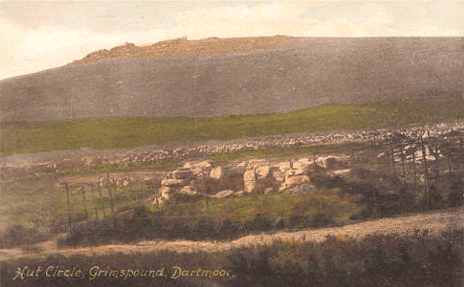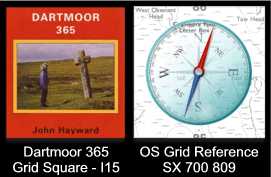
“The best known of many prehistoric settlements on Dartmoor, Grimspound dates from the late Bronze Age (about 1450–700 BC). The remains of 24 stone roundhouses survive here, within a massive boundary wall about 150 metres in diameter.” – English Heritage.
There can be no question that Grimspound is one of the things one must see on Dartmoor and undoubtedly many people do visit the place and have done for many years. Has it changed much over the years? Well its appearance is certainly a lot different to what is was in prehistoric times and ever since then man, time and the Dartmoor climate have made further changes to how it looks. Below is one visitors account of his ramble to Grimspound back in 1942, it certainly was a ‘ramble’ having reached there from Moretonhampstead via North Bovey. But what has changed over the past 75 years? Here are the thoughts and experiences of a “plain man“…
“My colleague and I were in the mood for a ramble on Dartmoor with Grimspound as out main objectives. To reach it we had intended to climb Yard Hill beyond North Bovey and then proceed through Combe Farm and over Hookney Tor. Before arriving at North Bovey, however, a minister of the Methodist Church gave us a lift in his car along the road which includes a steady climb up Langstone Hill. The reverend gentleman was on his way to hold a service at Manaton, and we enjoyed our little chat with him before alighting at Langstone Cross. Our walk from this point through Heatree to the foot of Hameldown was most picturesque. Before passing through Heatree Gate we could see the wide, grassy track that would lead us up the slope of Hameldown, and we could also easily pick out the outline of Berry Pound, which was remarkably clear in spite of its covering of thick bracken.
As I mounted the track the scent of bell heather was most delightful and the views as we climbed higher and higher were charming indeed. At one point we were high enough to command the combined view of Blackingstone Rock and Heltor, for I understand that they are rarely seen together from most points. I could also see spacious Easdon Tor with Haldon Tower beyond, Bowerman’s Nose. Honeybags and Haytor. On the other side was noble-looking Hameldown itself, and in between was the glorious Widecombe valley. From here to is a fine view of Moreton. I regard the grassy track to Grimspound as the pilgrim’s way of an ancient civilisation, for it is clearly defined, but it eventually narrows down to a moorland pathway through the heather, and following this we found that it led us right into Grimspound. Indeed, the sudden appearance of this aboriginal settlement came as a surprise.
At last I was standing in this famous enclosure. It had fascinated me ever since I saw it some months ago from Hookney Tor. This ancient village, with its remains of primitive dwellings and other buildings is certainly most interesting, and its builders showed great foresight in choosing its situation. On one side it is sheltered by Hameldown, and on the other by Hookney Tor; and a most important factor in its position is the neighbouring sporing, which for centuries has provided pure water. The main entrance, which is about 7ft. wide and formed of massive stones is rather imposing and its original paving is well preserved, and there are steps leading into the enclosure. The entrance through which we passed is much smaller. Grimspound covers about four acres, and many stones of its boundary wall have been much displaced in the passing of time. When built this wall must have been much higher. Indeed, I understand it was high enough to keep out wolves and raiding tribes in that wild spot. It was cavity wall filled with earth…
My impressions of Grimspound, of course, are those of a plain man who has been much impressed by it all. In my spare time I try to probe into the history of Dartmoor and take peeps into its past; but so far Grimspound, as one example, remains a profound enigma to me, as I am sure it has to many others. Still, it has conveyed some idea of the existence and habits of those very early settlers who carried on their calling and made their homes their. A fairly large portion of the area is free from buildings and I take it that this would be used for grazing when the needs arose, for the herds and flocks had to be kept within the confines. I understand the remainder of the area has 24 huts, half of which were dwellings and the rest cattle pens and store houses. Today, a large part of the pound is covered with heather, and on the day of our visit, by the way, there was an amazing abundance of whortleberries. In some of the pens the ground is covered with grass as smooth as a carpet. The centre dwelling which possibly occupied by the leader of this community, and which has a vestibule or forecourt adjoining, is protected by an iron railing.

In this hut we enjoyed our tea, well sheltered from the wind: and I tried to imagine the domestic scene of long, long ago, with the occupants dressed in skins from their sheep, sitting around the fire which I fancy, would be a cooking hole in the floor. A centre pole would support the roof of thatch reeds or wood. The least imaginative of us naturally fell some interest in the daily lives of those ancient people, and I realised that, after all, we are descended from that hardy race which from the evidence available must have possessed a great measure of adaptability if they lived there all year round.
While enjoying our pipes after tea we had a talk with a bright gentlemanly boy from Chagford, who was there with his twin sister, elder brother and parents, and I was most interested to learn that his name was Perrott; and I understand that he belongs to the family of the famous Dartmoor guide (James Perrott) of the same name of some seventy years ago. In those days Mr. Perrott’s services were in constant demand, and I have often wished I could have accompanied such a splendid guide on his moorland excursions. As I stood in Grimspound that day I wondered if the rocks on Hookney Tor had any connection with those prehistoric dwellers, for I noticed that some of the edges of the rocks are so perpendicular and sharp in outline that one would almost think they were erected by man, and that possibly some form of religious worship took place there. Grimspound is not quite without trees. There are two growing out of the apparently inhospitable stone wall, one being an elderberry and the other we could not name. My friend was of the opinion that they had grown from seeds dropped by birds. Leaving the pound and keeping to the track that leads to Hookney, we came upon a large stone circle which is almost in direct line with the centre of the pound and the rocks on the tor. The solitude hereabouts is most profound, and I may express it so, the spirit of solitude on Dartmoor strikes me as being ever present. Miss Sophie Dixon, who loved the moor, and who in her poetry has so delightfully interpreted its atmosphere, has a line which came to mind that afternoon. It is; ‘Where man himself but looks a mote, amid the solitude.’ – (On Longaford Tor poem)
Many ancient monuments in our land have disappeared in the march of time and of progress, but Grimspound remains an inseparable part of the moor, and like the Grey Wethers, it seems to be trying to tell us something of its long story. Such relics of the past certainly offer a wide field of interest and research to the antiquary. It was a grand walk home to Moreton, and before reaching Coombe Farm and the adjacent old mine workings we saw a stone avenue and more stone circles. They have their place, I suppose, in the absorbingly interesting history of this locality in which Grimspound plays the most prominent part.” – The Western Times, September 25th, 1942.
Certainly Berry Pound is still smothered by bracken but no longer will one see the iron railings around the main hut circle and gone ore the two trees growing from the outer outer walls. I am not sure whether today one could describe the grass as being like a “carpet” or that one could see an “amazing abundance of whortleberries.” Possibly one thing or things that might make an appearance today which I’m sure would astound the author in 1942 are the odd Highland Cattle resplendent with their handlebar horns wandering around the lanes. Just a slight aside here, you will see that the author encounters members of the Perrott family who were descendants of the famous James Perrott. Oddly enough his great, great grandson Tom, who now lives in Tasmania has just visited Dartmoor (October 2017) – I wonder if he was one of the people the author met?

“Of the large prehistoric pounds on the Moor this is the most frequently visited, for it is easily accessible and comparatively well preserved. It probably dates back to the early Bronze Age, say three thousand years ago...” John Hayward, Dartmoor 365, p.153.
 Legendary Dartmoor The many aspects past and present of Dartmoor
Legendary Dartmoor The many aspects past and present of Dartmoor
